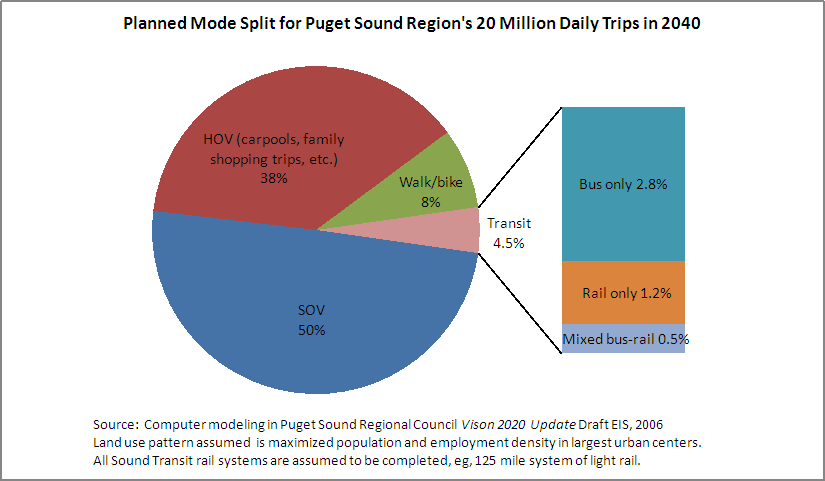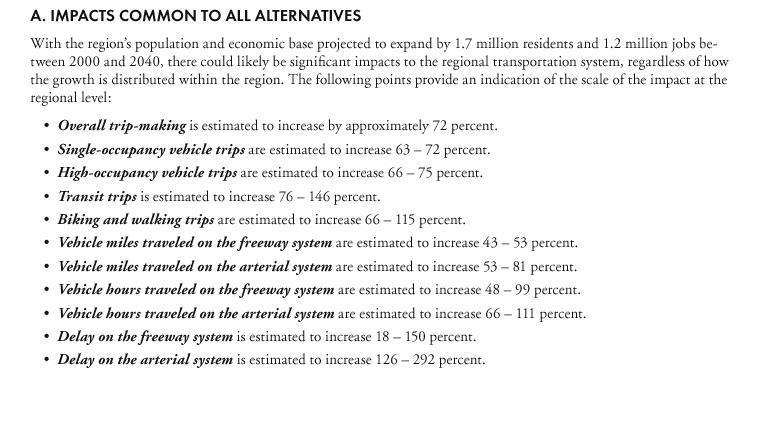![]()
![]()
Background: A ten-member Regional Transportation Commission (RTC) worked very hard in the second half of 2006 to examine Sound Transit, Puget Sound Regional Council, Washington State DOT, public transit agencies such as King County Metro, and municipal agencies such as Seattle and Tacoma transportation departments to improve transportation planning in Snohomish, King, Pierce, and Kitsap Counties. A final report has been issued.
John Niles of PITF brought the concerns in this article to the Washington State Legislature on February 22, 2007 in testimony on implementation of the RTC recommendations (pdf).
![]()
The Regional Transportation Commission (RTC) in an outline of its concerns posted here (external pdf) cites congestion, land use, project prioritization, and funding as important issues for improved transportation planning in the central Puget Sound region.
In support of RTC concerns about these issues, an important forecast has recently been published by the Puget Sound Regional Council (PSRC), the existing government planning authority, that Public Interest Transportation Forum recommends be highlighted by RTC in its forthcoming report to the State Legislature:
Finding: PSRC's computer modeling of the future (year 2040) performance of the full implementation of the existing Destination 2030 Metropolitan Transportation Plan shows that growing traffic congestion is the expected result. Four modeled alternatives include both the continuation of present trends and policies, and an alternative yielding much increased densification of housing and commercial space near future light rail and commuter rail train stations. Growing traffic congestion and falling transit market share is the result under all four land use pattern and density alternatives.
This forecast indicates a failure of existing planning organizations and processes, since the Destination 2030 Plan includes the projects specified in both the Sound Transit Long Range Plan for 125 miles of light rail and in the Regional Transportation Investment District (RTID) plans for highway improvements. The spending needed to implement Destination 2030 would be even more than is contemplated for the combined ST2 and RTID tax measure in November 2007.
A key Destination 2030 Plan mobility strategy is revealed as a stunning failure. That strategy is full implementation of Sound Transit's Central Link and Sounder railroad service between designated regional urban growth centers such as the downtowns of Seattle, Tacoma, Bellevue, and Everett. Light rail and commuter rail are intended to be an important alternative to congestion. But PSRC's forecasts reveal that taking the train is not going to be applicable for the trips of most people. The expectations for future transit market share have actually been lowered by PSRC since issuance of the Destination 2030 Plan in 2001, as shown in the following table:
| PSRC's Transit Market Share Forecast for Full Implementation of Destination 2030 Transportation Plan | |||
| 2001 forecast for 2030 | 2006 forecast for 2040 with no policy changes | 2006 forecast for 2040 with major policy changes | |
| Work Trips | 11.8% | 11.6% | 11.7% |
| All Other Trips | 3.3% | 2.5% | 3.1% |
Source: PSRC, Destination 2030, and Vision 2020 Update DEIS
The transit market share for all types of trips combined is 4.5%. The complete modal splits for all 20 million trips per day forecast in 2040 under the current Destination 2030 Transportation Plan are shown in the following graphic:

As shown in the graphic, even with 125 miles of light rail, the official projection is that most transit rides in the region in 2040 will be aboard buses.
Following is an excerpt on performance impacts published in the PSRC forecast of its Destination 2030 Metropolitan Transportation Plan performance:

Source document: Page 5.3.12 of the Draft EIS for the Vision 2020 Update (external pdf).
In the last two bullets, note the inability of the freeway and arterial systems, following implementation of Metropolitan Transportation Plan improvements, to handle increases in traffic volume. Delay on regional arterials is seen to be headed somewhere between doubling (100% increase) and quadrupling (300% increase).
More details and explanation about these PSRC computer-generated forecasts are provided on this page in PITF.
![]()
Return to the Public Interest Transportation Forum home page.
![]()
Last modified: February 07, 2011